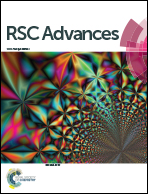Fabrication of mono-dispersed silica-coated quantum dot-assembled magnetic nanoparticles†
Abstract
Multifunctional nanoparticles (NPs) with magnetic and luminescent properties have garnered considerable attention in various fields of biomedical and physiological applications. In this study, we report the fabrication of QD-embedded silica NPs with an iron oxide NP core (Fe3O4@SiO2@QDs NPs) that has dual functional properties. The Fe3O4@SiO2@QDs NPs were mono-dispersed in size and exhibited super-paramagnetic and highly fluorescent properties. Most of the Fe3O4@SiO2@QDs NPs were naturally internalized into MDA-MB-231 human breast cancer cells, and the NP containing cells were successfully sorted by utilizing both fluorescence flow cytometry and a magnetic field. Results indicate that the Fe3O4@SiO2@QDs NPs have great potential for multimodal cell separation.


 Please wait while we load your content...
Please wait while we load your content...